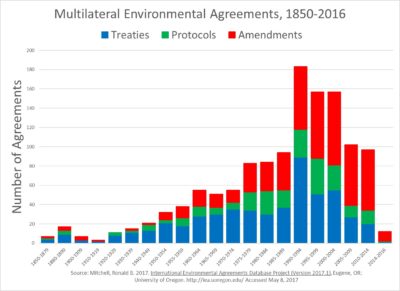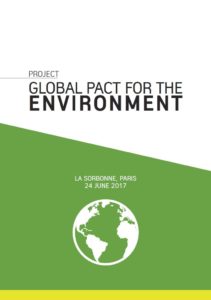Will There Be a Global Environmental Constitution?
The potential of a proposed Global Pact for the Environment remains uncertain

International Environmental Agreements Database Project.
The 1990s were the heyday of international environmental lawmaking. The 1992 United Nations “Rio Conference” on Environment and Development catalyzed the UN Framework Convention on Climate Change (UNFCCC), Convention on Biological Diversity, and the UN Convention to Combat Desertification. The decade also witnessed the launch of the Rotterdam Convention on Prior Informed Consent as well as protocols such as the Madrid Protocol on Environmental Protection in Antarctica, the Kyoto Protocol to the UNFCCC, and five protocols to the Convention on Long-Range Transboundary Air Pollution. Others agreements — such as the UN Convention on the Law of the Sea — came into effect. Perhaps as a result of all this action, the current motivation for and marginal value of additional agreements are now both low.
However, some observers are concerned that international environmental law remains insufficient in its scope, depth of commitments, and breadth of participation. Some legal scholars, activists, and others advocate for a comprehensive Global Pact for the Environment. The proposed Pact got its start at the Club des Juristes, a French legal think tank, whose expert group wrote a draft Pact in 2016. In 2017 the Club hosted a high-profile conference in Paris, where the Pact was endorsed by French President Emmanuel Macron, among others.
What the Pact might be, which states might ratify it, and what impacts it might have are highly uncertain, in large part because there are multiple distinct visions of it. The Pact’s website originally gave its primary objective as:
to become the cornerstone of international environmental law. It would strengthen the coherence of global environmental governance within a context of fragmented international institutions and a multiplicity of environmental norms both technical and sectoral.
The Pact supplements the legal framework of fundamental norms… [It] would establish[] a third generation of fundamental rights, the rights related to environmental protection.
The 2017 draft of the Global Pact [PDF] would establish a right to an ecologically sound environment and a concomitant duty to take care of the environment, as well as codify several extant general principles — including sustainable development, intergenerational equity, precaution, and polluter pays — as obligations with binding force within international law. This ambitious vision of a comprehensive, legally binding agreement based on a right to a healthy environment was soon echoed in a white paper [PDF], which described the pact as having
binding value to complete the body of legislation and strengthen codified principles [that] will support, accompany and frame the environmental constitutionalism currently developing in domestic legal systems.

When Pres. Macron presented the Pact to the UN in September 2017, the Club’s draft, its white paper, and the right an an ecologically sound environment were absent, and the objective had seemingly been scaled back to “to bring together and expand the basic principles of environmental law. It is to be both legally binding and general, enunciating all the basic environmental rights [that] it is designed to protect and the major principles of environmental law that must guide the actions of the States parties.”
Early the following year, the UN General Assembly passed a resolution “Towards a Global Pact for the Environment” [PDF], requesting “a technical and evidence-based report that identifies and assesses possible gaps in international environmental law and environment-related instruments with a view to strengthening their implementation” and established an ad hoc committee
to consider the report and discuss possible options to address possible gaps in international environmental law and environment-related instruments, as appropriate, and, if deemed necessary, the scope, parameters and feasibility of an international instrument, with a view to making recommendations, which may include the convening of an intergovernmental conference to adopt an international instrument
Gone now are also any expansion of international environmental law, codification of principles as legally binding, and references to a “global pact” within the resolution body. Instead, the resolution points to possibly strengthening existing instruments’ implementation and filling gaps via an instrument that might (or might not) be legally binding. In November, the UN Secretary-General’s office released the report “Gaps in international environmental law and environment-related instruments: towards a global pact for the environment” [PDF]. Its conclusions are limited, as are its recommendations:
International environmental law and its effective implementation could be strengthened through such actions as the clarification and reinforcement of principles of international environmental law. This could be done through a comprehensive and unifying international instrument that gathers all the principles of environmental law. There should also be more effective reporting, review and verification measures and robust compliance and enforcement procedures and mechanisms, ensuring that those States that require support have adequate resources to enable them to effectively implement their commitments, and the role of non-State actors should be enhanced at multiple levels.
In short, the idea has evolved from a legally binding, quasi-constitutional international environmental treaty, to a call to merely clarify and gather existing principles, improve reporting and enforcement, and ensure international financial support.
Analysis of the proposed Global Pact for the Environment abounds [1, 2, 3, 4, 5], but much of it conflates the early, ambitious vision and the ongoing, modest UN effort. Our friends at the Columbia Center on Sustainable Investment solicited and gathered diverse thoughts from nineteen scholars. Among these, my Emmett Center colleague Alex Wang calls for an agreement that fairly recognizes the different roles of net producing and net consuming states. Two other commentators capture some of my skepticism toward the Pact endeavor. Daniel Bodansky of Arizona State University says:
In the descriptive sense, legal gaps (or non liquets) exist, if at all, only in very rare cases where the law does not decide an issue one way or the other – where an action is neither permitted nor prohibited. Whether any such gaps exist in [international environmental law] is doubtful, since ordinarily the absence of a legal rule regulating an issue (say, plastics pollution or protection of a species) does not create a gap in the law; it simply means that, legally, states are free to act as they choose.
UNGA resolution 72/277 seems to use the term, “gaps,” in its normative rather than descriptive sense, as things that need to be filled. But identifying such gaps is not a technical exercise; it depends on what legal rules or agreements one believes should exist. Is the lack of a general agreement setting forth environmental principles (like the Global Pact) a gap? The question does not have an objective, evidence-based answer. It depends on political and moral judgments about whether such an agreement would serve a useful purpose and hence be a good thing.
Susan Biniaz, former Deputy Legal Adviser of the US State Department and now at Yale University, makes similar points:
the identification of “gaps” may not be straightforward. Theoretically, a gap might involve subject matter, stringency, coverage, legal character, enforcement, resources, institutions, or political will. However, one person’s “gap” may be another person’s intentional design choice…
Assuming a gap(s) exists – marine pollution from plastics comes to mind — States should consider its environmental significance and the urgency/desirability of addressing it. If they decide to proceed, options include, e.g., an amendment, a new instrument (legal or not), increased funding, capacity-building for domestic enforcement, mobilizing international attention (e.g., through a summit), or model legislation…
It is vital that global political effort — a precious commodity – be channeled into the most environmentally beneficial outcomes.
Although the early ambitious draft Pact from the Club des Juristes was dead-on-arrival at the UN, I’ll add three critiques it because Bodansky and Biniaz cover key points regarding potential gaps and because the phenomena that I describe below are, to varying degrees, too common among scholars of international environmental law. First, because states’s preferences vary and because international law is based on their consent, developing an international agreement requires trade-offs between the breadth of participation and the depth of commitments. Moreover, an excessively broad scope increases the number of states that object to one or another provision and consequently reject the agreement. Fragmentation is an expected, and perhaps tolerable, consequence. Yet the 2017 draft has both a broad scope and deep commitments, while the accompanying white paper envisions “A binding and widely ratified Global Pact for the Environment.”
Second, international diplomats have been negotiating international environmental agreements, in their contemporary form, for almost fifty years. There is no reason to think that states’ current (non)participation in existing multilateral agreements fails to reflect their preferences while a new, comprehensive agreement would do so more accurately. To offer an example, European states are more supportive of relatively strong international environmental commitments and consequently ratify such agreements, including many regional ones, that other states have and continue to reject. A Global Pact would not alter these revealed preferences. This is not to suggest that new international agreements can never have added value, only that one that would attract substantial participation will have marginally more ambitious scope and commitments.
Third, the draft was tone-deaf to developing countries’ needs and desires. The traditional division between the global North’s desire for universal commitments to environmental protection and the global South’s concern that this would restrict its economic development, which is often based on the extraction of natural resources, is a long-standing and understandable barrier to deepening international environmental law. The grand compromise to bridge this division has been coupling states’ obligation to reduce and prevent transboundary environmental harm with their right to exploit their own natural resources pursuant to their own policies. However, the latter was absent from the Pact’s early draft. This omission is reflective of the composition of the Club’s Group of Experts, which residents of developed countries and especially academics dominated.
Next week, the UN’s ad hoc working group will hold its first substantive session in Nairobi, and should present its conclusions late this year. I suspect that many members of the Club’s Group of Experts will be disappointed by the resulting modesty of any resulting instrument.






Reader Comments